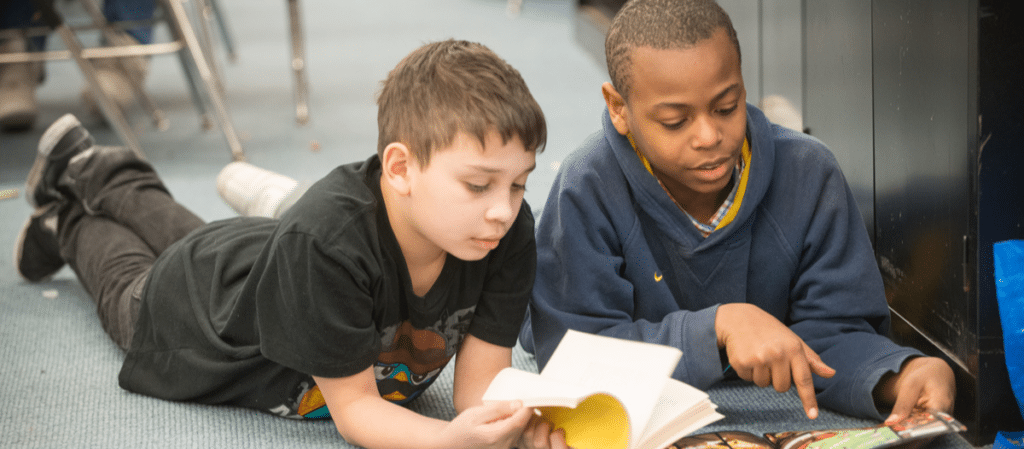In addition to identifying a set of academic competencies, the core belief of Responsive Classroom lays out a set of social and emotional competencies that students need in order to be successful in and out of school. Those competencies—cooperation, assertiveness, responsibility, empathy, and self-control—are captured in the acronym C.A.R.E.S.
Incorporating the C.A.R.E.S. competencies into your lessons can have an enormous positive influence on your classroom; these competencies prepare students to successfully learn, play, work, and form relationships with their peers by teaching them how to be in control of their own behavior and how to make good choices for themselves. But what does integrating these skills into the classroom look like in practice? Below you will find the outline I have used in my kindergarten and first grade classrooms to integrate the teaching of the C.A.R.E.S. competencies into each day and throughout the year.
Choose a C.A.R.E.S. Competency and Mentor Text
Incorporating C.A.R.E.S. competencies into your students’ learning starts with taking stock of where your students currently are:
- Observe individual students and the classroom community, and use what you notice about them to choose one C.A.R.E.S. competency as a focus.
- Select a mentor text that you can read aloud to students to illustrate the competency in action. (For younger students, stick to shorter stories with limited characters so they quickly become familiar with the text.)
- Read the story once or twice beforehand to establish familiarity with the thoughts, feelings, and actions of the characters.
Introduce and Define the Competency
Once you have made a plan, it’s time to introduce the competency to students:
- Share with students the competency, its definition, and the mentor text. (To define each competency in grade-appropriate language, you can use the C.A.R.E.S. Standards for a Course of Study.)
- Help students recognize the competency in the mentor text by making connections between the definition and characters’ actions in the story.
- Reread the mentor text. Include think-alouds about the characters’ self-talk, reinforce the definition, and ask students to talk with each other about the challenges and successes characters experience when using the competency.
- Create an anchor chart with a picture of the read-aloud book cover, the competency, and the definition. Display the anchor chart where everyone can see it, and continue to add to it over the next week or two.
Build Understanding Through Reinforcing Language
As students begin trying out their new knowledge, your role is to positively reinforce their efforts:
- Over the next several days, notice and reinforce the competency whenever you see it!
- Recenter classroom rules by connecting the competency to each rule.
- Add photographs, student quotes, and classroom stories to the anchor chart to create a collection of materials that illustrate the competency in action.
Broaden Understanding by Collaborating With Special Area Teachers and Families
You can expand the support network students have for working on their new competency by including the other significant adults in their lives:
- Connect with special area teachers to inform them about the competency your class is working on, the definition, and some successes students are having in practicing the competency.
- Before a specialist class, ask students to notice how they use the competency and check in with them after the class to reflect.
- Communicate with families so they are aware of the competency and can reinforce it at home.
Integrate Into Morning Meeting and Closing Circle
These routines, which start and end the day, provide students with structured opportunities to discuss and practice their new competency. During these meetings, try out any of the following:
- Write prompts for partner sharing or dialogue sharing that focus on the competency.
- Teach students to ask questions and give comments focused on the competency.
- Select Morning Meeting activities that create opportunities to practice the competency. Use reflection after the activity to strengthen students’ understanding.
- Write morning messages that further build each student’s identity as a person who possesses and practices these competencies.
- During closing circle, reflect on and celebrate how students’ growing social-emotional competencies help them and their classmates throughout the school day.
Continuing C.A.R.E.S.
Making the commitment to teach your students the C.A.R.E.S. competencies comes with its own intrinsic rewards: you get to watch students gain proficiency in a skill that will serve them the rest of their lives and see how that new skill positively transforms your classroom. Once you have successfully introduced a new competency to your students, it’s time to build on that competency by focusing on a different SEL standard or introducing a different C.A.R.E.S. competency. There is always more opportunity for growth. Get started today!
Julia Monke is a consulting teacher for Center for Responsive Schools and a first grade teacher in Minneapolis.
